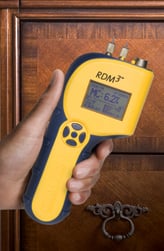 Most people are familiar with the common uses for a moisture meter as a tool for construction workers and water damage restoration experts. However, there are more uses for these devices than just making sure that a concrete slab can meet ASTM F-2170 standards and making sure that a room which was once compromised by moisture intrusion is now dry again.
Most people are familiar with the common uses for a moisture meter as a tool for construction workers and water damage restoration experts. However, there are more uses for these devices than just making sure that a concrete slab can meet ASTM F-2170 standards and making sure that a room which was once compromised by moisture intrusion is now dry again.
What are a few of these unconventional uses for moisture meters? Here are three less well-known uses for moisture meters, pulled right from our “Moisture Meters 101” guide:
Use #1: Checking the Effectiveness of Your HVAC System
Here’s a common scenario, especially for people living in hot and humid areas along the coastline; the thermostat for the building is reading a nice, cool 74 °F, but everyone is sweating. You’re not sure if the HVAC is working, if the thermostat itself is busted, or if the room’s ambient humidity is just making it feel as though you’re covered in sweat.
A thermo-hygrometer can be used in a building to take a reading of both the actual temperature and the relative humidity of the room. Compare the results of the thermo-hygrometer’s readings to the thermostat. Does the temperature reading come close to the one given by the thermostat? If so, what is the relative humidity of the room? The answers to these question may tell you if your HVAC system is completely on the fritz, or if you have a high level of moisture in the building that is making people feel uncomfortable.
With a thermo-hygrometer, you may be able to diagnose the problem without having to go to the expense of hiring a professional HVAC technician to investigate it, or at least know for certain that you need one.
Use #2: Pest Control
Did you know that common household pests such as ants, termites, cockroaches and rats are drawn to areas with high concentrations of moisture? For years now, pest control experts have taken advantage of this fact to locate the highest concentrations of pests in a building so that they can eliminate the problem.
How do exterminators find these areas with high moisture? By using moisture meters to pinpoint the source of the moisture in a structure.
With these devices, an exterminator can find a pocket of moisture hidden in the materials of a structure, track it to a likely source, and plant bait, poison, and traps as necessary. Also, he or she can alert the building’s owner to the source of the moisture so that it can be removed, eliminating a source of nutrition for the unwanted pest animals.
It is important to remove these pests whenever they’re found because they can do severe damage to the building and its materials. For example, mice can chew through electrical wiring, termites will eat wooden support structures, and many other pests act as a carrier for different diseases, making them a health risk to humans.
Speaking of health risks, that brings us to our last unusual use for moisture meters in this list…
Use #3: Improving Health and Safety at the Workplace
Damp building materials are a hazard to the health and safety of people in the workplace. Not only do damp drywall, wood flooring, and even concrete pose a risk of developing mold which can be a health hazard for people with sensitive respiratory systems, they serve as a breeding ground for bacteria.
A combination of mold and bacteria contributes to increased incidents of illness among people who work near these health hazards. By using moisture meters to find damp building materials, building owners can find these risk areas for breeding bacteria and remediate them, which reduces the risk for workers falling ill (leading to a commensurate reduction in sick days used).
Check out the Moisture Meters 101 Guide
Get the guide to learn more about the benefits of moisture meters, the different kinds of moisture meters out there, and how they work. Simply click the link below to get started!
Comments